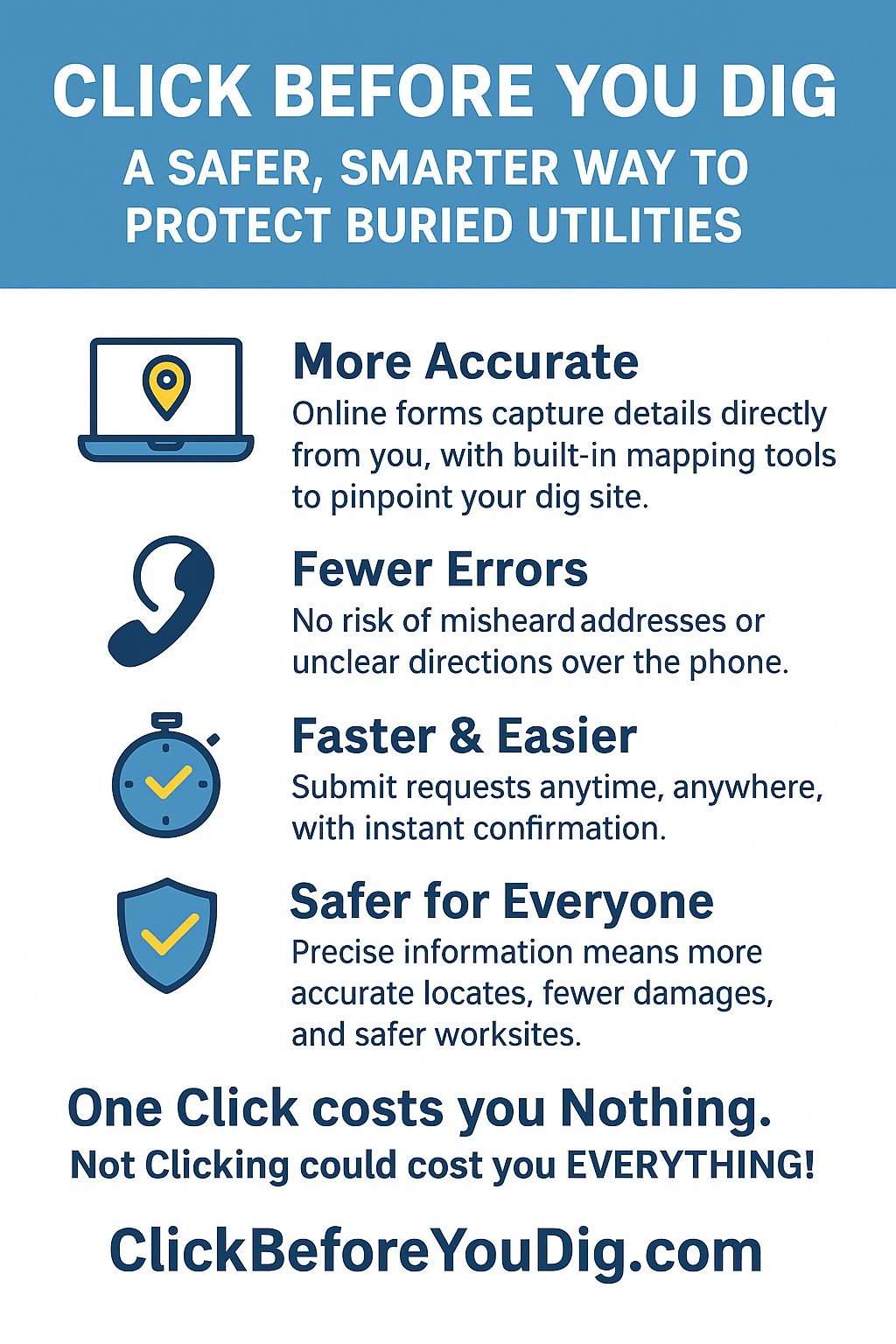From Calls to Clicks: How Online Locating Requests Reduce the Risk of Utility Damage
Print this Article | Send to Colleague
Mike Sullivan, President, Utility Safety Partners

For decades, the familiar “Call Before You Dig” message has been central to damage prevention. By dialing a 1-800 number, and now a three-digit number across the USA, homeowners and contractors could request that underground utilities be located before starting excavation. This system has prevented countless incidents of damaged pipelines, severed communication lines, and electrical hazards. But as technology and work practices evolve, damage prevention stakeholders are recognizing a more effective approach: shifting locate requests from calls to clicks. And it’s reducing damages!
Encouraging people to file their locate requests online—through a Notification Centre web portal or mobile app—has proven to reduce errors, improve efficiency, and ultimately lower the risk of damaging buried infrastructure.
Why Online Requests Are Safer
1. Greater Accuracy of Information
When a request is phoned in, details about the dig site, scope of work, and contact information must be communicated verbally, then transcribed by a Contact Centre agent. This introduces opportunities for misunderstanding or clerical errors—misheard street names, incorrect spelling, or vague descriptions of excavation boundaries. Online requests, by contrast, allow excavators to enter the information directly. Many systems now include digital mapping tools that let users outline the precise dig area, reducing ambiguity and ensuring locators know exactly where markings are required.
2. Better Mapping Precision
Modern Notification Centre web portals are integrated with GIS mapping. Excavators can drop a pin on a digital map, trace the work area, and confirm the exact location. This spatial accuracy is difficult to achieve in a phone conversation and drastically reduces the chance that locators will be sent to the wrong address or a generalized location. The more precise the ticket, the more effective the locate—and the safer the excavation.
3. Fewer Communication Barriers
Phone-based requests depend heavily on language skills, accents, or noisy jobsite environments, all of which can create misunderstandings. Clicking through an online form eliminates these barriers. Standardized fields guide the user through the process, ensuring that all necessary information is captured consistently and in the format required by utility operators.
4. Efficiency and Speed
Online requests typically take less time to process. Excavators can submit tickets 24/7 without waiting on hold. For the Notification Centre, electronic submissions reduce workload on Contact Centre Agents and free them to focus on complex requests or customer support. Faster, cleaner processing means utilities receive tickets more quickly and can respond sooner.
5. Data Integrity and Recordkeeping
An online ticket generates a clear, standardized digital record—complete with timestamps, mapping data, and confirmation receipts. This eliminates transcription errors and provides an audit trail in the event of disputes or incidents. Stronger records not only improve accountability but also feed into analytics that help utilities and regulators identify trends and improve safety programs.
The Link Between Fewer Errors and Fewer Damages
Every error or ambiguity in a locate request increases the odds that buried infrastructure will be missed, mismarked, or left unprotected. A mislocated gas pipeline, an unmarked fiber optic line, or an overlooked electrical cable can lead to costly repairs, service outages, environmental damage, injuries, or even fatalities.
By reducing the opportunities for miscommunication and by providing locators with precise, standardized information, online “click” requests directly address the root causes of utility damages. Several Notification Centres in North America report significantly lower damage rates on excavation projects initiated by web tickets compared to those started over the phone.
Building a Culture of Clicking
While the benefits are clear, achieving widespread adoption requires education and encouragement. Contractors and homeowners need to know that online requests are not only more convenient but also safer. Public campaigns are evolving from “Call Before You Dig” to “Click or Call” and “Click Before You Dig,” reflecting the industry’s commitment to making online requests the default choice.
Damage prevention depends on accuracy, clarity, and timeliness. By shifting calls to clicks, the damage prevention process is strengthened from the very beginning. Fewer errors mean more accurate locates, and more accurate locates mean fewer damages. For utilities, contractors, and communities, encouraging online ticket submission isn’t just about convenience—it’s about safety, reliability, and protecting the infrastructure that keeps society running.

